Since 2010 celery anthracnose (aka leaf curl) has become a major challenge in large celery production regions in Michigan and Ontario and sporadically occurs on farms in Georgia, Pennsylvania, New York and New England. It attacks muck- and mineral-ground celery plantings and does not appear to affect celeriac or other closely related crops.
Symptoms
Listed from the first noticeable and progressing to the most severe, include:
- Small, slightly sunken, light brown elliptical lesions or cracks on the stalks
- Curling leaves (usually downward cupping) and twisting petioles
- Pale green (not yellowed) color, with or without stunting
- Sunken dark brown or black lesions along stalk edges, particularly on young heart tissue
- Ruptured, greenish to light brown outer stalk lesions, frequently containing gall tissue or adventitious roots
- Slimy, brown to black rot of the heart tissue that leaves the intact, outer leaves standing
Causal agent
Celery leaf curl, which describes the most recognizable early symptom, is the descriptive name used when this disease first showed up – before the causal pathogen was identified. We more commonly call it celery anthracnose because we now know that an anthracnose fungus causes this disease.
The anthracnose species primarily responsible for fruit rots in tomato and pepper do not cause celery anthracnose. Celery anthracnose is caused by a tightly related cluster of Colletotrichum (pronounced col-le-TA-tre-cum) species formerly referred to as Colletotrichum acutatum. Researchers have just recently been able to use genetic identification techniques to determine that at least two species in that old grouping cause celery anthracnose. C. fioriniae and C. nymphaeae are the major species causing celery crop losses in Ontario, Canada. C. nymphaeae has also been implicated in Japanese outbreaks of celery anthracnose. Both cause disease in fruit crops; C. fioriniae is responsible for bitter rot of apples while C. nymphaeae causes strawberry anthracnose. C. fioriniae also causes anthracnose of garlic scapes, which has been seen in garlic growing near where celery anthracnose developed the previous year.
Disease cycle
How celery anthracnose arrives on a farm is unclear. Some recent work suggests that seeds may carry the pathogen, which helps explain why symptoms often start in greenhouse transplant production. The pathogen is easily spread in the field by water and splashing soil. The life span and persistence of the celery anthracnose fungus in the soil isn’t well understood at this point. Once on the farm, celery anthracnose fungi can infect several weeds. Common lambsquarters, redroot pigweed, yellow nutsedge, oakleaf goosefoot, and common groundsel all can harbor celery anthracnose without clearly expressing symptoms themselves. This is an important feature of celery anthracnose: the pathogen can infect a plant then lay quietly in an asymptomatic state (a latent or quiescent infection) until environmental conditions become favorable.
Celery anthracnose thrives under warm, wet conditions. Rapid disease development occurs when temperatures are 77 – 86oF, with substantially more disease development at 86 than 77. Temperatures as cool as 60 will support fungal growth and spread, but field progression will be slow. Wet leaves facilitate anthracnose development. Long wet periods of 48 – 96 hours best promote outbreaks, though as little as 12 hours is sufficient to cause disease. It takes 3-5 days after infection for the small, sunken stalk lesions to appear. The curling starts just days after the initial lesions. Celery anthracnose frequently develops when it has been very hot with heavy thunderstorms followed by high humidity. Overhead irrigation and poor airflow due to weedy fields also increase leaf wetness periods and exacerbate disease development.
Full disease outbreaks in celery can cause heavy losses. When environmental conditions favor disease, severity can range from 17 to 100% and cause marketable yield loss of 2 – 80%. In cooler, drier weather, infections can be as low as 1 – 10% with very little to no loss in marketability. Losses in western NY fields have ranged from 20 to 100%. If an infection is mild and the heart tissue is unaffected, some plants with celery anthracnose can be marketed after trimming.
Management
For starters, become familiar with the symptoms. Next, keep the greenhouse free of weeds – a relevant practice for most crops because greenhouse weeds are a common source of insects and diseases.
Scout your plug trays before transplanting into the field. Remove suspicious seedlings and treat the remaining ones, or consider starting over and using new plug trays.
Consider your rotations. Don’t plant into fields with a history of anthracnose developing on celery or garlic scapes. It isn’t currently clear whether C. nymphaeae will move from strawberries to celery and vice versa. Assess your comfort level for rotating those two crops, especially following strawberries that had anthracnose. To be cautious, don’t move from an infected celery or strawberry planting into a clean field of either crop when doing field work. The current recommendation is to rotate away from celery and garlic for 3 to 4 years.
Separate plantings of susceptible crops. Don’t plant celery near garlic or strawberry.
Minimize overhead irrigation if possible.
Use drip irrigation instead, especially if there is celery anthracnose in the transplants or past occurrence at your farm. Using plastic or other mulch will help reduce water splashing and weed pressure.
Scout your celery planting during a long hot period or a few days after a short one. Hold off on scouting until the foliage dries. Pay particular attention if you’ve had heavy rain, high humidity, or used overhead irrigation. Look for curling leaves and then examine the stalks and hearts of plants more closely. Remember that aster yellows, a look-a-like disease, requires the presence of leaf hoppers for transmission, produces pronounced yellowing, and does not cause dark stem lesions.
Least susceptible varieties:
- Merengo
- Hadrian
- Geronimo
- Balada
Moderately susceptible varieties:
- Sabroso
- TZ 6010
Highly susceptible varieties:
- Plato
- TZ 9779
- Stetham
- Kelvin
- Nero
- Green Bay
- Dutchess
Fungicides
Fungicides can help slow celery anthracnose progression and retain marketable yield. Applications should be directed at the most susceptible young tissue in the heart of the plant. Trials examining fungicide efficacy most often make 1 application before the disease starts, so keep in mind that field results may not be as good if sprays begin after disease is found. Stobilurin (aka QoI) fungicides (FRAC Group 11) best reduce celery anthracnose progression in the field and best help to maintain yield. Cabrio consistently performs well. Stobilurin fungicides really should be applied with a protectant and be rotated with non-group 11 fungicides because of resistance concerns. Those with a label restriction statement about number of consecutive applications permitted legally must be rotated. Rhyme is a group 3 fungicide labeled for anthracnose. Treat any infected seedlings with a group 11 when they are set in the field. Cuprous oxide forms of copper can help in low pressure weather conditions, but do little when environmental conditions are highly favorable. See Table below for a list of which fungicides are registered in NY as of 2021 to treat celery anthracnose as well as early and late blight of celery. Anthracnose must be specified on the label to use for this disease in NY.
Ongoing work at the University of Guelph is showing good disease control success by using the TOMCAST forecasting model to help time fungicide applications. Researchers are testing spray application thresholds of 15 and 25 disease units. To date they have found that both provide the highest level of control possible and are more economical than calendar sprays because fewer applications are required. Reducing the number of applications will make rotating fungicide groups much more achievable. Remember that protectant fungicides applied for celery early and late blight are generally effective against a broad range of diseases and may have a secondary benefit of allowing you to postpone treatment for anthracnose.
With good cultural practices and fungicide use, sporadic outbreaks can often be controlled enough to harvest a portion of an infected planting. While celery may not be a major crop in NY, celery anthracnose tends to cause major losses when it shows up. There is ongoing research into celery anthracnose in Ontario and Pennsylvania which will hopefully lead to improved future control.
Fungicide options available in NY (as of 2021) for common celery foliar diseases.
Always check the product label for the most thorough and current application information.
| Fungicide | Active Ingredient | FRAC Group | Diseases Listed | Rate & Notes | PHI (days) |
| Cabrio | Pyraclostrobin | 11 | Anthracnose, Early & Late Blight |
12-16 oz /A, 64 oz/yr max ≤ 2 sequential apps |
0 |
| Pristine | Pyraclostrobin/ boscalid |
11 + 7 | Anthracnose, Early & Late Blight |
10 -15 oz /A, 2 apps/yr |
0 |
| Merivon * | Pyraclostrobin/ fluxapyroxad | 11 + 7 | Anthracnose, Early & Late Blight |
4-11 fl oz, 3 apps/yr |
1 |
| Rhyme * | Flutriafol | 3 | Anthracnose, Early & Late Blight |
5-7 fl oz /A, 4 apps/yr |
7 |
| Quilt | Azoxystrobin/ propiconazole |
11 + 3 | Early & Late Blight | 14 fl oz /A, max of 1.5 lb azoxystrobin products/yr | 14 |
| Quadris | Azoxystrobin | 11 | Early & Late Blight | 9.0-15.5 fl oz /A, 1 spray then rotate groups |
0 |
| Flint | Trifloxystrobin | 11 | Early & Late Blight | 2-3 oz /A | 7 |
| Tilt | Propiconazole | 3 | Early & Late Blight | 4 fl oz /A | 14 |
| Bravo WeatherStik | Chlorothalonil | M5 | Early & Late Blight | 2-3 pt/A, protectant | 7 |
| Various | Cuprous oxide | M1 |
Check the label of your preferred formulation |
||
| Switch | Cyprodinil/ fludioxonil | 9 + 12 | Late Blight | 11-14 oz/A | 0 |
* Not for use in Nassau and Suffolk Counties on Long Island.
Photos
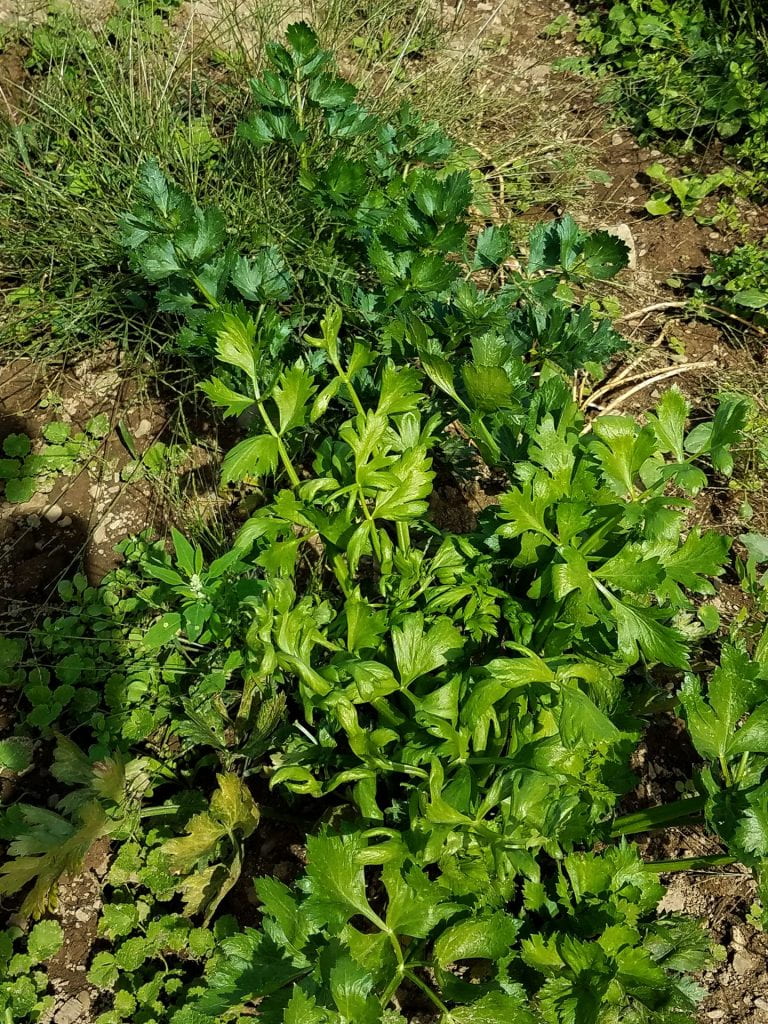
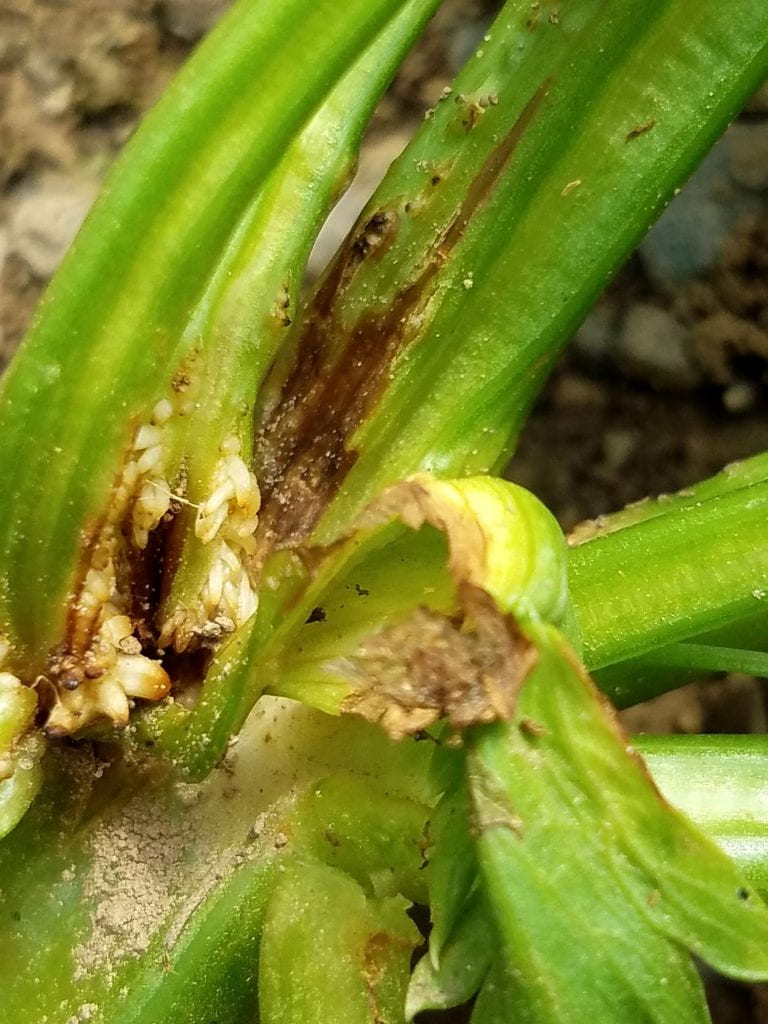
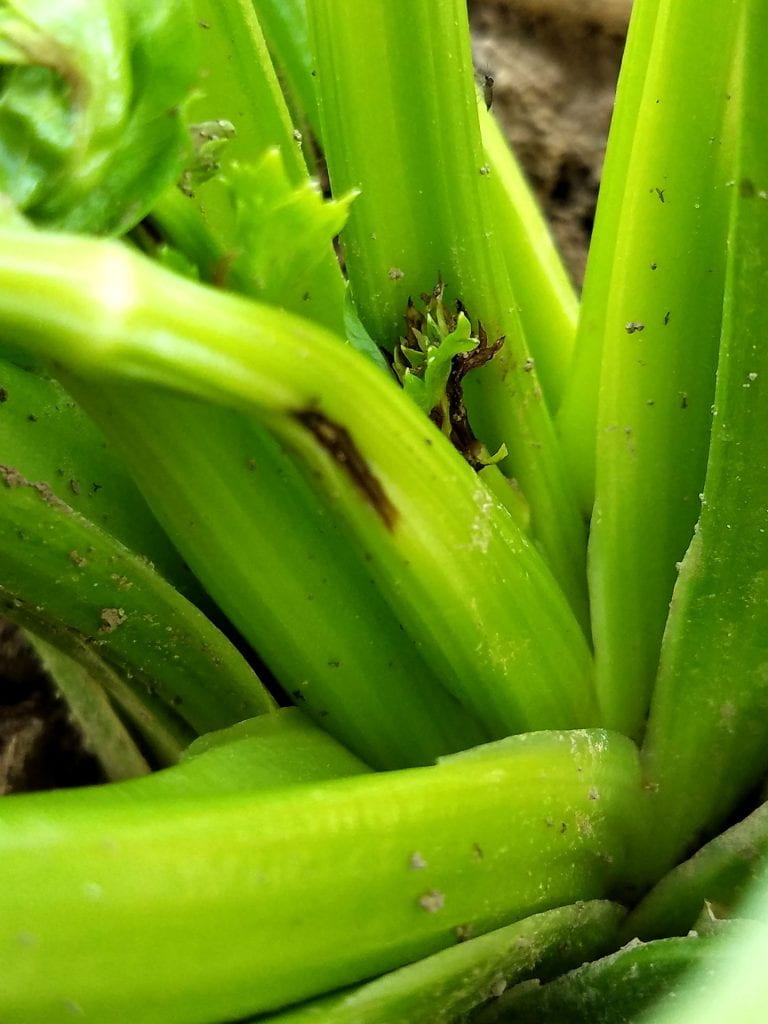
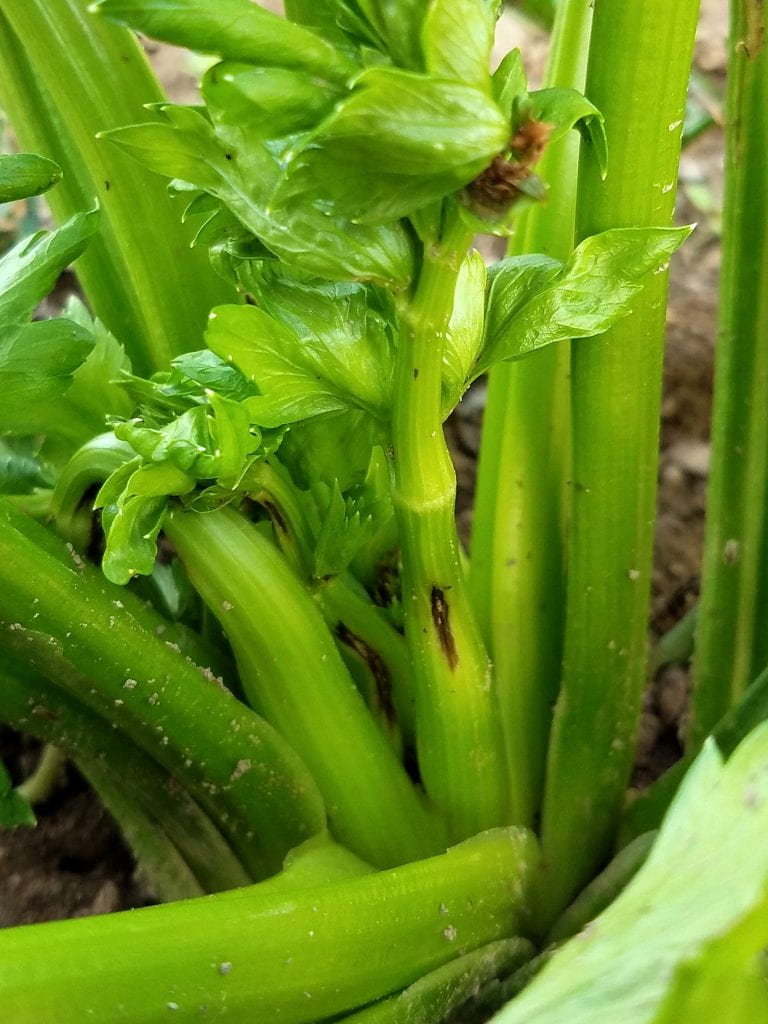
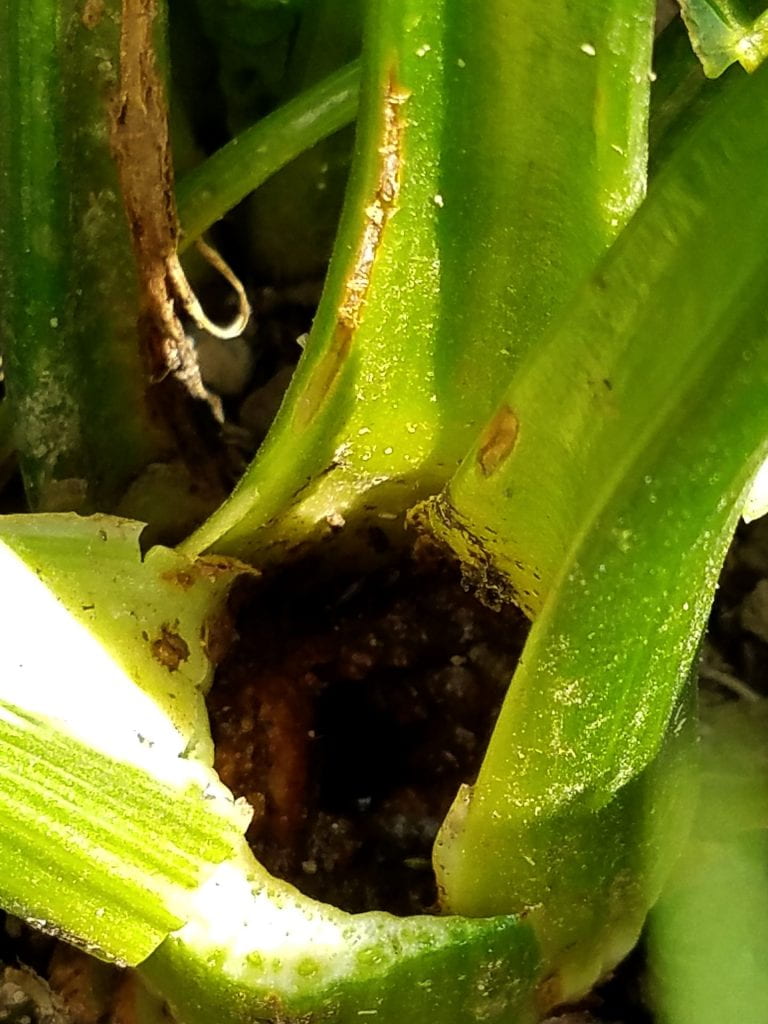
References
Hausbeck MK, Rodriguez-Salamanca L, Wiriyzjitsomboon P (2012) Celery Disease Update. In Proceedings of the 2012 Great Lakes Fruit, Vegetable and Farm Market EXPO.
Jordan B, AK Culbreth, J Brock (2018) First report of leaf curl on celery caused by Colletotrichum acutata senso lato in Georgia. Plant Dis. 102(8):1657.
McDonald MR, K Vander Kooi (2015) Evaluation of fungicides for the control of celery leaf curl, 2015. University of Guelph Muck Crops Research Station Annual Research and Cultivar Trial Reports, pp96-97.
McDonald MR, K Vander Kooi (2015) Evaluation of various celery cultivars for susceptibility to celery leaf curl, 2015. University of Guelph Muck Crops Research Station Annual Research and Cultivar Trial Reports, pp 98-99.
McDonald MR, K Vander Kooi (2016) Evaluation of fungicides for the control of celery leaf curl (anthracnose), 2016. University of Guelph Muck Crops Research Station Annual Research and Cultivar Trial Reports, pp 104-105.
McDonald MR, K Vander Kooi (2017) Evaluation of fungicides for the control of celery leaf curl (anthracnose), 2017. University of Guelph Muck Crops Research Station Annual Research and Cultivar Trial Reports, pp 98-99.
Raid R, D Spriensma, J Klamer, and B Klamer (2015) Evaluation of fungicides for management of celery anthracnose caused by Colletotrichum acutatum, 2014. Plant Disease Mgmt. Reports 9:V117.
Reynolds S, Celetti MJ, Jordan K, McDonald MR (2016) Evaluation of weather-based forecasting models to manage leaf curl on celery crops in Ontario, 2016. University of Guelph Muck Crops Research Station Annual Research and Cultivar Trial Reports, pp 108-109.
Reynolds S, Celetti MJ, Jordan K, McDonald MR (2016) Host specificity and survival of Colletotrichum species on celery and common weeds of the Holland Marsh, Ontario, 2016. University of Guelph Muck Crops Research Station Annual Research and Cultivar Trial Reports, pp 110-112.
Reynolds S, Celetti MJ, Jordan K, McDonald MR (2016) Screening for cultivar resistance to manage leaf curl on celery crops in Ontario, 2016. University of Guelph Muck Crops Research Station Annual Research and Cultivar Trial Reports, pp 106-107.
Reynolds S, Celetti MJ, Jordan K, McDonald MR (2017) Evaluation of weather-based forecasting models to manage leaf curl on celery crops in Ontario, 2017. University of Guelph Muck Crops Research Station Annual Research and Cultivar Trial Reports, pp 96-97.
Reynolds S, Celetti MJ, Jordan K, McDonald MR (2017) Host specificity and survival of Colletotrichum species on celery and common weeds of the Holland Marsh, Ontario, 2017. University of Guelph Muck Crops Research Station Annual Research and Cultivar Trial Reports, pp 100-103.
Reynolds S, Celetti MJ, Jordan K, McDonald MR (2017) Screening for cultivar resistance to manage leaf curl on celery crops in Ontario, 2017. University of Guelph Muck Crops Research Station Annual Research and Cultivar Trial Reports, pp 94-95.
Rodriguez-Salamanca LM, LM Quesada-Ocampo, RP Naegele, MK Hausbeck (2015) Characterization, virulence, epidemiology, and management of anthracnose in celery. Plant Disease 99(12)1832:1839.
Yamagashi, N (2017) Studies on disease cycle and control of celery stunt anthracnose caused by Colletotrichum nymphaeae. J General Plant Pathology 83(6):429-430.
Personal communications with Stephen Reynolds and Mary Ruth McDonald, University of Guelph and Sara May, Penn State.
More information/prepared by:
Elizabeth Buck
Extension Vegetable Specialist
Cornell Vegetable Program
cell 585-406-3419
email Elizabeth
Created summer 2019. Updated with Margaret McGrath March 2021


